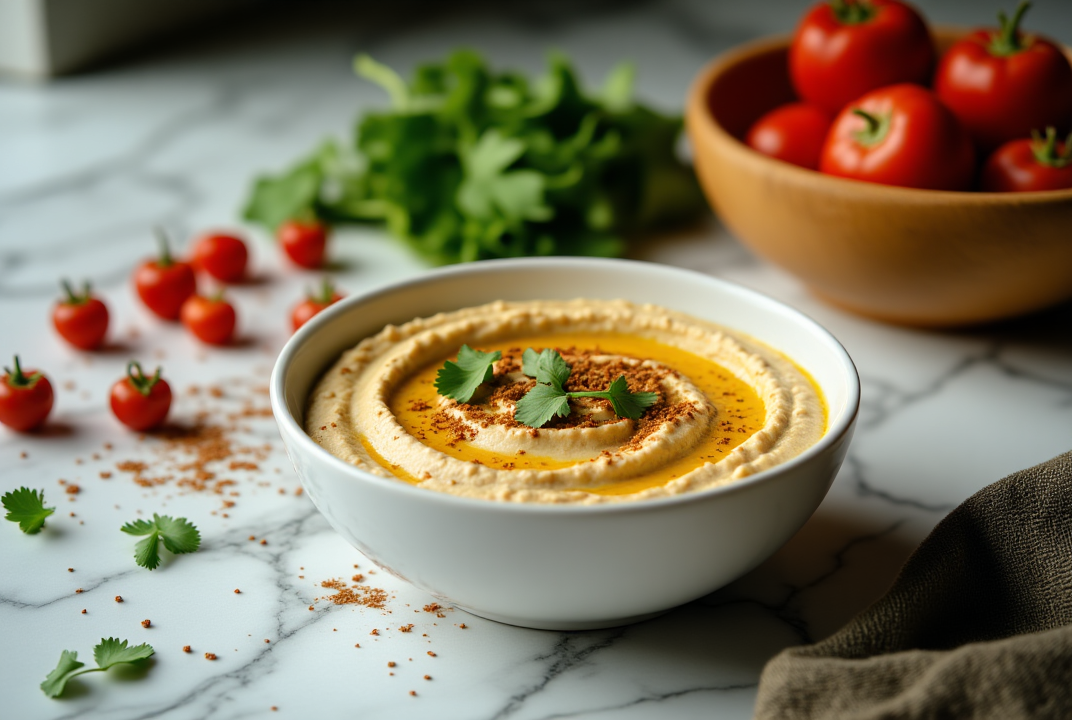
As Keto continues to gain popularity, many health-conscious eaters are rethinking their favorite snacks—including hummus. While this chickpea-based spread is often praised for its wholesome ingredients, its carb count can be a sticking point for those keeping a close eye on macros. Here, we’ll dive into the facts about hummus and Keto, helping you decide if it deserves a spot in your meal plan and sharing creative, low-carb alternatives to keep your snacking both satisfying and on track.
What Is Hummus Made Of?
Hummus is traditionally made from a blend of cooked chickpeas, tahini (a paste made from sesame seeds), olive oil, fresh lemon juice, garlic, and salt. These simple ingredients are combined to create a smooth, creamy dip with a rich, nutty flavor and a hint of tanginess from the lemon. Some variations may include spices like cumin or paprika, or garnishes such as chopped parsley or a drizzle of olive oil, but the core recipe remains centered around chickpeas and tahini, giving hummus its distinctive taste and texture.
What Makes Hummus Such a Popular Dip?
- Creamy Texture: Hummus offers a smooth, velvety consistency that makes it perfect for dipping and spreading.
- Rich, Savory Flavor: The combination of chickpeas, tahini, olive oil, and garlic creates a deliciously bold and satisfying taste.
- Nutrient-Dense Ingredients: Packed with plant-based protein, fiber, and healthy fats, hummus is both nourishing and filling.
- Versatility: Hummus pairs well with a wide variety of foods, from fresh vegetables and crackers to sandwiches and wraps.
- Dietary Inclusivity: Naturally vegan and gluten-free, hummus appeals to people with diverse dietary needs and preferences.
Is Hummus Keto?
Hummus is not typically considered Keto-friendly because its main ingredient, chickpeas, contains a moderate amount of carbohydrates that can quickly add up and push you over your daily carb limit on a strict Keto diet. While a small serving of hummus may fit into a more flexible low-carb plan, most traditional recipes provide around 4–6 grams of net carbs per two-tablespoon serving, which can make it challenging to enjoy in larger quantities without impacting ketosis. For those committed to staying in ketosis, it’s important to monitor portion sizes carefully or explore lower-carb alternatives made with ingredients like cauliflower or zucchini.
Low-Carb Dips and Spreads
Cauliflower Hummus
Cauliflower hummus is a popular low-carb alternative that swaps chickpeas for steamed cauliflower, dramatically reducing the carb content while maintaining a creamy, satisfying texture. Blended with tahini, olive oil, lemon juice, and garlic, this dip delivers the familiar flavors of traditional hummus with a fraction of the carbs. It’s perfect for pairing with fresh veggies or as a spread for Keto-friendly wraps and sandwiches.
Guacamole
Guacamole is naturally low in carbs and packed with healthy fats, making it a staple for anyone following a Keto or low-carb lifestyle. Made from ripe avocados, lime juice, cilantro, and seasonings, guacamole offers a rich, creamy dip that’s both nutritious and delicious. Enjoy it with sliced cucumbers, bell peppers, or as a topping for grilled meats and salads.
Greek Yogurt Dips
Greek yogurt dips, such as tzatziki or herbed yogurt spreads, provide a tangy, protein-rich option for low-carb snacking. By using full-fat Greek yogurt as a base and adding ingredients like cucumber, garlic, dill, or chives, you can create a refreshing dip that’s light on carbs but big on flavor. These dips are ideal for dipping raw vegetables or using as a sauce for grilled chicken or fish.
Baba Ganoush
Baba ganoush is a smoky, creamy dip made from roasted eggplant, tahini, olive oil, and lemon juice. With fewer carbs than traditional hummus, baba ganoush is a flavorful way to add variety to your low-carb snack lineup. Its robust taste pairs well with crunchy vegetables or Keto-friendly crackers, making it a satisfying choice for those seeking new flavors.
How Many Carbs Are in Traditional Hummus?
Traditional hummus contains about 4 to 6 grams of net carbs per two-tablespoon serving, primarily due to its main ingredient, chickpeas, which are naturally higher in carbohydrates. While this amount may seem modest, the carbs can add up quickly if you enjoy hummus in larger portions, making it challenging for those on a strict Keto diet to stay within their daily carb limits. For anyone tracking macros closely, it’s important to measure servings carefully and consider how hummus fits into your overall carb allowance for the day.
Can You Eat Small Amounts of Hummus on Keto?
Yes, you can eat small amounts of hummus on Keto, but portion control is essential due to its carb content. A typical two-tablespoon serving of traditional hummus contains about 4 to 6 grams of net carbs, which can fit into a daily Keto carb limit if you plan carefully. Enjoying hummus in moderation—paired with low-carb vegetables like celery, cucumber, or bell peppers—allows you to satisfy cravings without jeopardizing ketosis. Always track your servings and consider your total daily carb intake to ensure hummus fits comfortably within your Keto goals.
Which Foods Can You Pair With Hummus to Keep It Low-Carb?
|
Food |
Why It’s Low-Carb |
How to Enjoy With Hummus |
|
Celery Sticks |
Very low in carbs and high in fiber |
Dip directly for a crisp, fresh bite |
|
Cucumber Slices |
Refreshing, hydrating, and low in carbs |
Scoop hummus for a cool crunch |
|
Bell Pepper Strips |
Naturally sweet, colorful, and low-carb |
Use as dippers for added flavor |
|
Zucchini Rounds |
Mild taste and minimal carbs |
Top with hummus for mini bites |
|
Radish Slices |
Crunchy, peppery, and low in net carbs |
Pair for a zesty, satisfying snack |
|
Broccoli Florets |
High in fiber and low in carbs |
Dip for a nutrient-packed combo |
|
Cauliflower Florets |
Low-carb and neutral in flavor |
Use as sturdy hummus scoops |
|
Cherry Tomatoes |
Lower in carbs than many fruits |
Enjoy in moderation with hummus |
Common Keto Dips and Spreads Mistakes To Avoid
- Overlooking Hidden Carbs: Many store-bought dips and spreads contain added sugars or starchy fillers that can quickly increase your carb intake without you realizing it.
- Ignoring Serving Sizes: It’s easy to underestimate how much you’re eating, but even Keto-friendly dips can add up if you don’t measure your portions.
- Choosing the Wrong Dippers: Pairing dips with high-carb foods like pita chips or crackers can sabotage your low-carb efforts, so always opt for non-starchy vegetables or Keto-approved alternatives.
- Not Checking Ingredient Labels: Failing to read labels can lead to consuming unwanted ingredients like vegetable oils, preservatives, or artificial flavors that aren’t ideal for a clean Keto diet.
- Relying Only on Store-Bought Options: Homemade dips and spreads give you full control over ingredients and macros, while store-bought versions may contain hidden carbs and unhealthy additives.
Conclusion
Hummus remains a beloved dip for its flavor and versatility, but its carb content means it’s not always the best fit for a strict Keto diet. By understanding portion sizes and choosing low-carb dippers, you can still enjoy small amounts of traditional hummus without compromising your goals. For those seeking more flexibility, there are plenty of delicious, Keto-friendly alternatives like cauliflower hummus, guacamole, and Greek yogurt dips that deliver both taste and nutrition. With mindful choices and a little creativity, you can keep your snacks exciting, satisfying, and perfectly aligned with your low-carb lifestyle.
Final Thoughts
Wondering how to boost your Keto or Paleo diet with even more flavor and nutrition? Check out Dr. Kellyann’s best sellers for delicious options like chicken bone broth, beef bone broth, and french onion bone broth, all crafted to support gut health and vitality. Looking for a new twist? Try the zesty Greek Lemon Chicken Bone Broth for a nourishing upgrade. Visit Dr. Kellyann’s to discover more ways to fuel your wellness journey with wholesome, Keto-friendly choices.
Sources
- https://www.inspiredtaste.net/15938/easy-and-smooth-hummus-recipe/
- https://www.urmc.rochester.edu/encyclopedia/content?contenttypeid=76&contentid=16057-1
- https://www.nutritionix.com/i/o-organics/traditional-hummus/56c146aacd96166e6c52ba93







